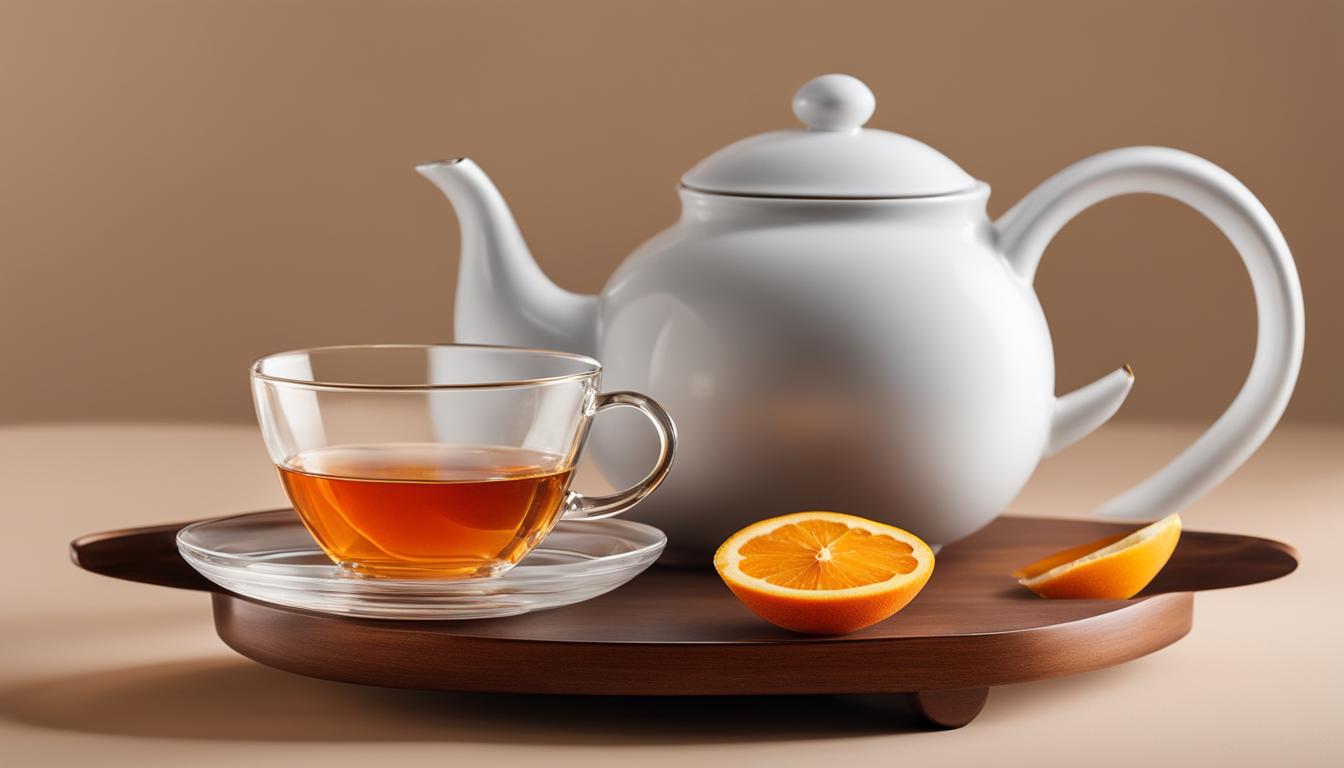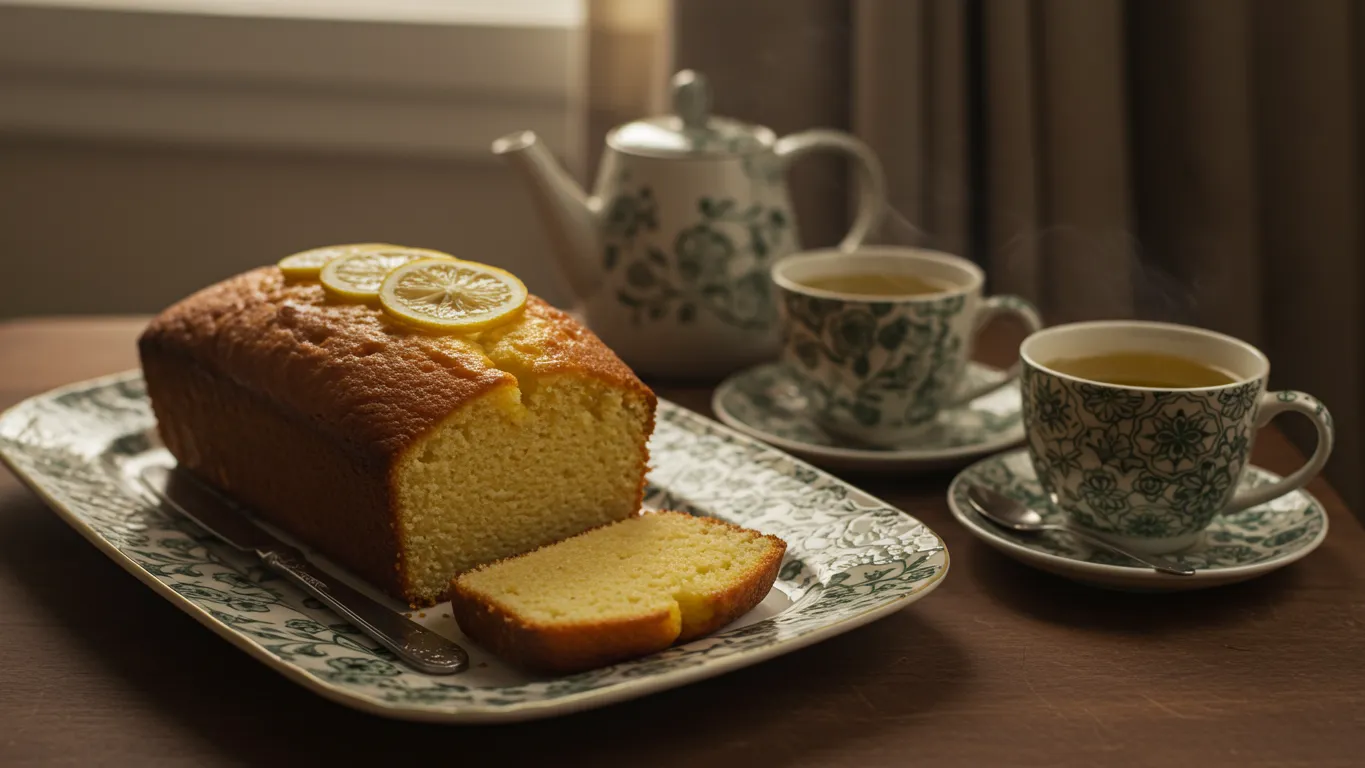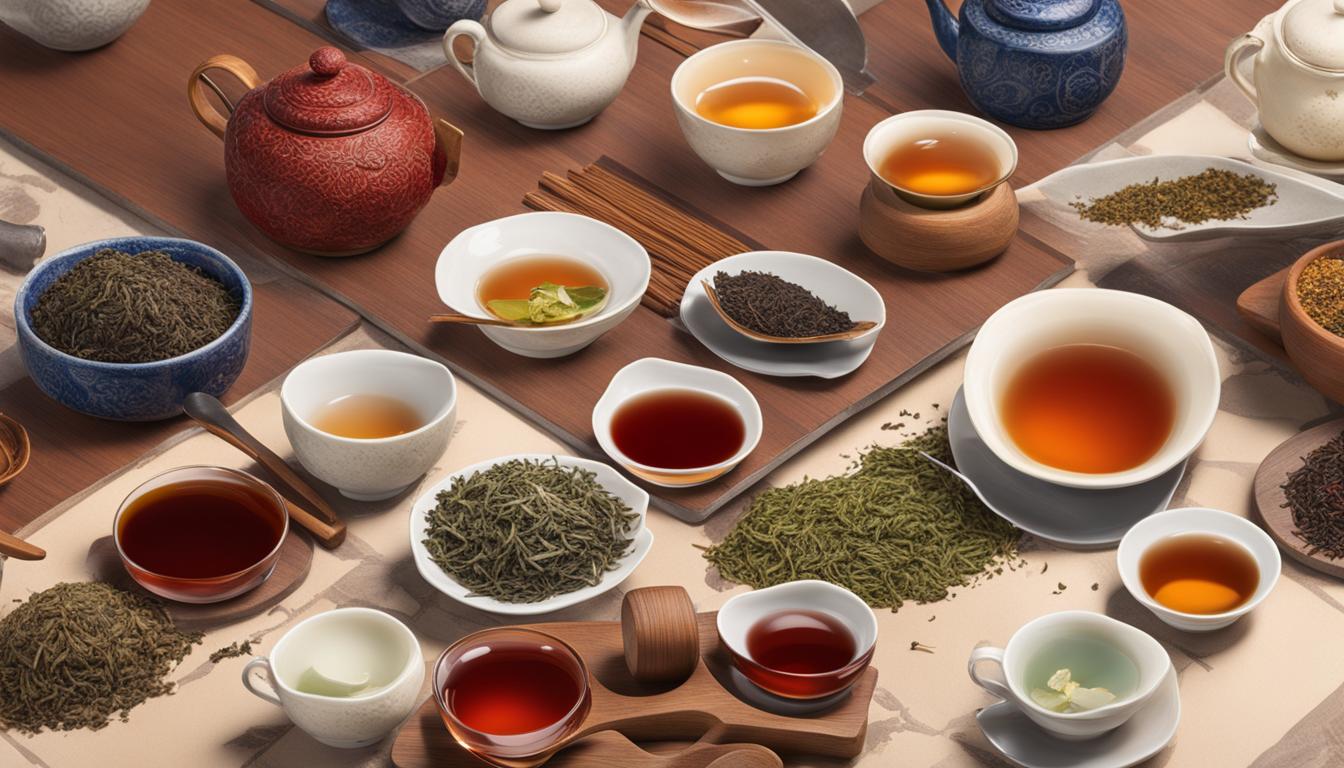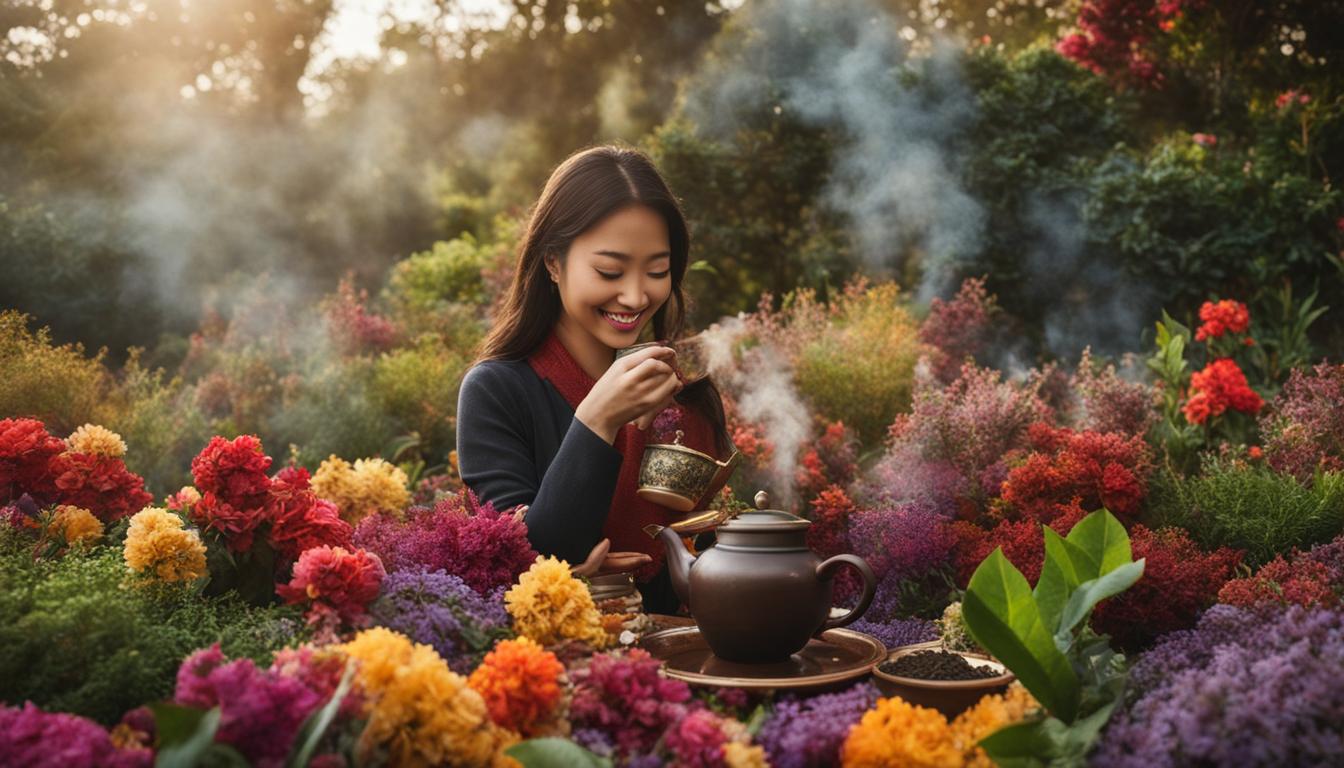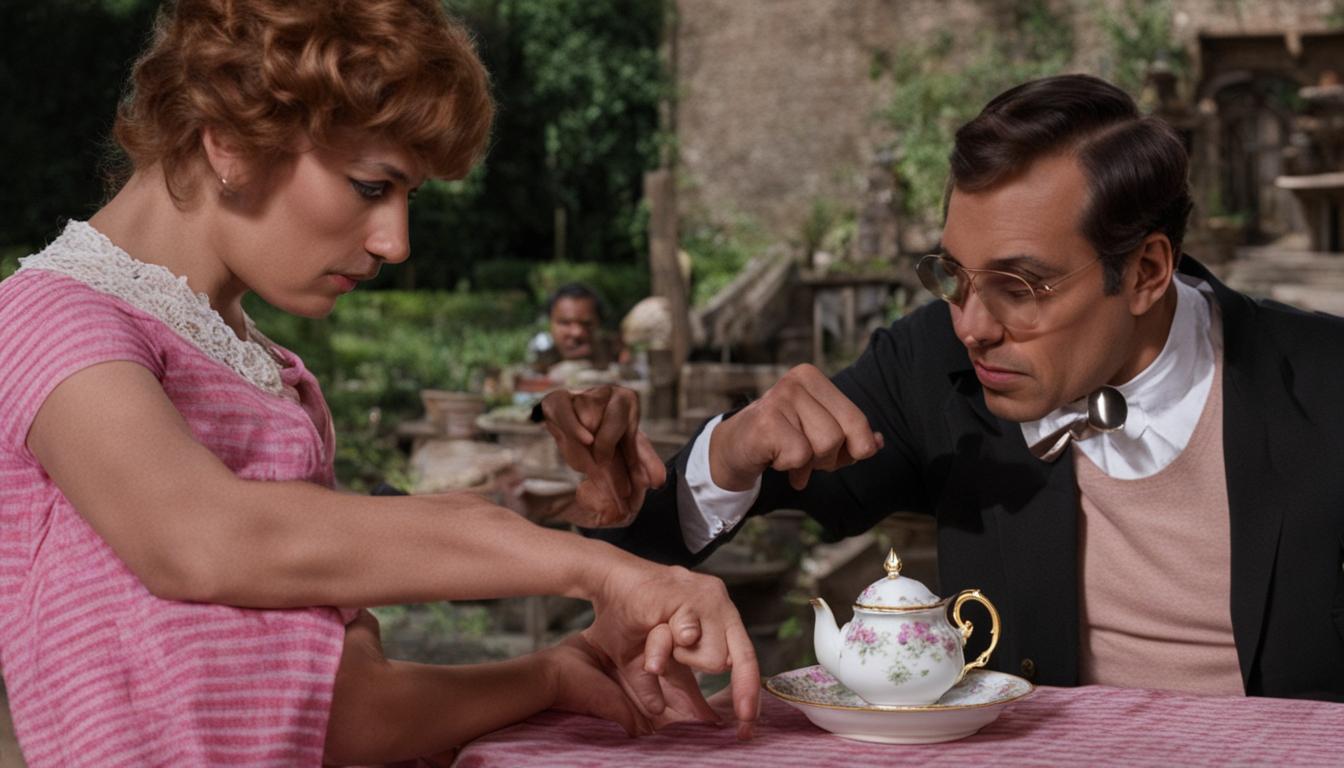Welcome to our culinary world, where we dive deep into the fascinating science behind tea and food pairings. Here, we unlock the secrets to creating unforgettable flavor combinations that will take your dining experience to new heights. So grab a cup of tea, and let’s embark on this flavorful journey together!
Key Takeaways:
- Tea and food pairing is an art that can enhance the dining experience.
- Tea sommeliers have extensive knowledge of tea origins, production methods, and flavor profiles.
- Consider the flavor profiles and weight of both tea and food when pairing.
- Tea aromas and flavors can enhance the taste of different foods.
- Experimentation and regional cuisines offer exciting pairings.
The Basics of Tea and Food Pairing
When it comes to pairing tea with food, understanding the flavor profiles of both is essential. Different types of tea have distinct characteristics that can either complement or clash with certain foods. Delicate and subtle teas, such as white and green teas, pair well with light dishes like salads and seafood. These teas have a refreshing and clean taste that enhances the flavors of these dishes. On the other hand, fuller-bodied teas like black teas can stand up to more flavorful foods like grilled meats and rich desserts. Their robust and bold flavors can complement and balance the intensity of these dishes.
One important factor to consider when pairing tea and food is the bitterness of tea. Some teas, especially those with longer steeping times or higher tannin content, can have a bitter taste. However, this bitterness can be balanced with sweet or acidic foods. For example, pairing a bitter black tea with a slice of lemon cake can create a harmonious combination of flavors. The sweetness of the cake counters the bitterness of the tea, resulting in a well-rounded and enjoyable taste.
When selecting a tea pairing, it’s also crucial to consider the weight and consistency of the food. Light teas go well with lighter dishes, while stronger teas can hold up to heavier and more substantial foods. For example, a delicate white tea might be overwhelmed by a hearty steak, while a robust oolong tea can complement the richness of a creamy pasta dish. By matching the weight of the tea with the weight of the food, you can create a harmonious balance that allows both flavors to shine.
The Art of Tea and Food Pairing: Tips and Tricks
- Experimentation is key: Don’t be afraid to try out different combinations of tea and food. The best pairings often come from unexpected combinations.
- Consider the aromas: Just like wine, tea has a wide range of aromas that can enhance the flavors of food. Floral teas can pair well with light and fragrant desserts, while earthy teas can complement savory dishes.
- Balance contrasting flavors: Pairing contrasting flavors can create an exciting and unique taste experience. For example, a spicy tea can be paired with a sweet dessert to create a contrast of flavors that stimulate the taste buds.
Exploring the world of tea and food pairings can open up a whole new realm of culinary possibilities. By understanding the basics of tea flavor profiles and how they interact with different foods, you can create harmonious and delightful combinations. So grab your favorite tea and start experimenting with different dishes to unlock the full potential of tea and food pairing.
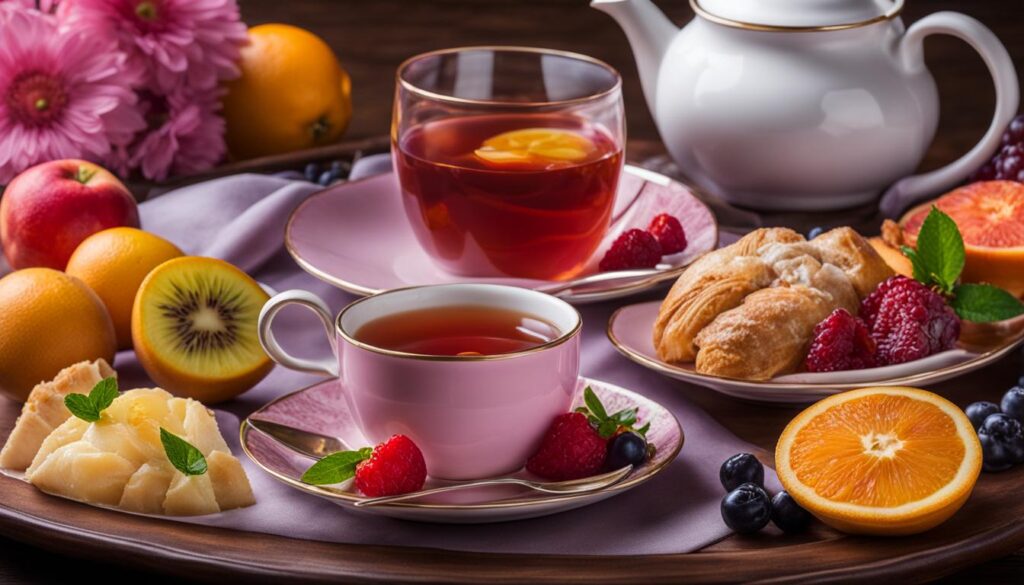
The Role of Tea in Enhancing Flavors
Tea is not just a beverage; it is a sensory experience that can elevate the flavors of different foods. The aromas and flavors of tea can complement and enhance the taste of various dishes, creating a harmonious pairing. When exploring tea and food combinations, it is essential to consider the wide range of aromas and flavors that different types of tea offer.
Tea can have floral notes, toasted undertones, nutty flavors, or vegetal characteristics, depending on its type and origin. For example, a delicate white tea with its subtle floral aroma can beautifully complement light and delicate dishes like fresh salads or seafood. On the other hand, a robust black tea with its bold and rich flavor can hold up well against stronger and spicier foods like curries or barbecued meats.
In addition to considering the aromas and flavors of tea, the concept of tea terroir also plays a significant role in tea and food pairings. Just like wine, tea can be influenced by its growing region, climate, and soil composition. Tea from different regions can have unique flavor profiles that can complement specific cuisines. For instance, Chinese green teas with their grassy and vegetal notes pair exceptionally well with Asian cuisines, while Indian black teas with their malty and robust flavors are a perfect match for spicy Indian dishes.
The Science of Tea Terroir and Cuisine
“Tea and food pairings are like a dance of flavors, where tea enhances the taste of dishes, and dishes bring out the nuances of tea. It’s all about finding that perfect balance and creating a symphony of flavors on the palate.” – Tea Sommelier
Exploring the science behind tea and food pairings can unlock a world of unique and delightful flavor combinations. By understanding the aromas, flavors, and influences of tea terroir, one can create harmonious pairings that enhance the dining experience. Whether you’re enjoying a fragrant green tea alongside a light salad or savoring a bold black tea with a flavorful curry, the role of tea in enhancing flavors cannot be underestimated.
The Art of Contrasting Pairings
When it comes to tea and food pairings, the art of contrast can take the sensory experience to new heights. By deliberately pairing foods and teas that create opposing sensations, we can create a symphony of flavors on our taste buds. Imagine savoring a fresh and slightly astringent tea alongside a plate of oily and greasy delicacies – the crispness of the tea cutting through the richness of the food, creating a perfect balance.
But what exactly happens when we combine tea and food in such contrasting pairings? It’s all about the chemical reactions that occur between the two. Just like in the world of wine and food pairings, the flavors in tea and food can interact with each other, enhancing or balancing certain taste elements. The result is a complex and satisfying taste experience that is far more than the sum of its parts.
In fact, the goal of contrasting pairings is to create a balance where no element overpowers the other, but each exalts the flavor of the next. It’s a delicate dance between tea and food that requires careful consideration of both their profiles. The key is to experiment and explore the possibilities – discover the unexpected combinations that surprise and delight your taste buds.
“Contrasting pairings in tea and food can create an exciting and unique sensory experience.”
The Chemistry of Tea and Food Pairings
When we talk about the chemistry of tea and food pairings, it’s important to understand that it’s not just about taste. The chemical reactions that occur between the compounds in tea and food can create new flavors and aromas that enhance the overall experience.
For example, the bitterness of tea can be balanced by pairing it with sweet or acidic foods. This is because the compounds responsible for the bitter taste in tea can bind with sweet or acidic molecules, reducing the perception of bitterness and creating a more pleasant taste sensation. Similarly, the astringency of some teas can be softened when paired with fatty or oily foods, as the fat molecules can coat the tongue and reduce the sensation of dryness.
By understanding the chemical reactions that occur between tea and food, we can create pairings that not only taste good but also provide a multi-dimensional sensory experience. So go ahead, experiment with contrasting flavors and let your taste buds embark on a thrilling journey of discovery.
Table 4: Examples of Contrasting Pairings
| Tea | Food Pairing |
|---|---|
| Earl Grey | Dark chocolate |
| Green tea | Sushi |
| Oolong | Spicy curry |
| Chamomile | Rich and creamy cheesecake |
Table 4 showcases some popular examples of contrasting pairings that can elevate your tea and food experience. The floral and citrus notes of Earl Grey tea complement the intense flavors of dark chocolate, creating a harmonious combination. Meanwhile, the delicate and vegetal flavors of green tea provide a refreshing contrast to the savory and umami-rich taste of sushi. Oolong tea, with its complex and slightly roasted profile, pairs wonderfully with spicy curry dishes, offering a delightful balance of flavors. Lastly, the soothing and floral notes of chamomile tea enhance the creamy and decadent nature of rich cheesecake.
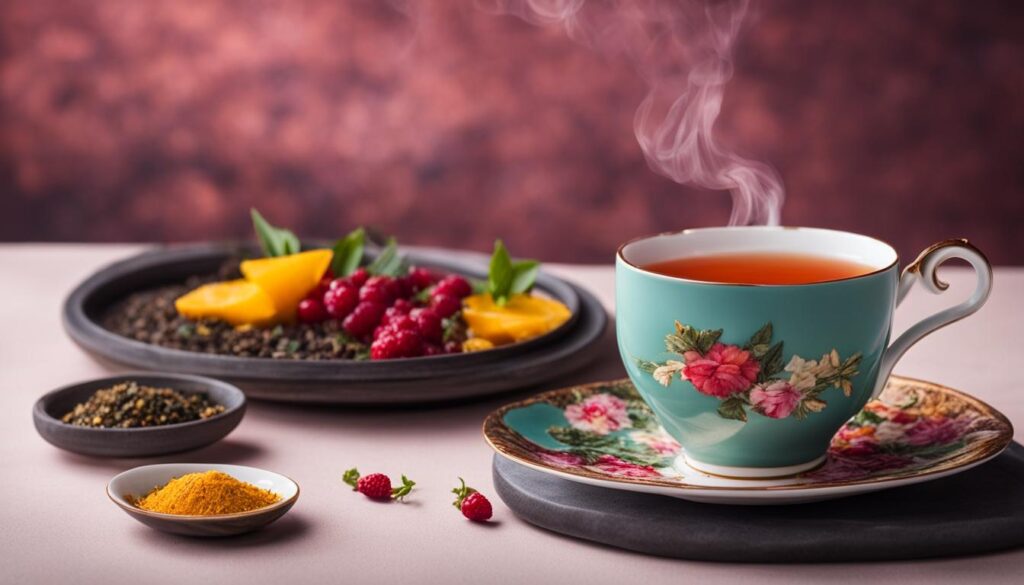
The Delight of Regional Cuisine
Exploring regional cuisines can provide inspiration for new and exciting tea and food pairings. Each culture has its own unique flavors and ingredients, which can be combined with different teas to create delightful flavor combinations. Trying spicy dishes, delicate seafood, and other regional specialties with different types of tea can offer a sensory experience that is both educational and enjoyable. Tea tasting techniques, similar to wine tasting, can be used to fully appreciate the aromas and flavors of different teas when paired with specific foods.
Tea Pairing Science Explained
Tea pairing is an art that combines scientific principles with culinary creativity. The flavors and aromas of tea can interact with the flavors of food in complex ways, enhancing and complementing each other. By exploring regional cuisines, we can discover new and unexpected combinations of tea and food that create unique and memorable dining experiences.
Tea Tasting Techniques for Food
When it comes to tea and food pairings, tasting techniques play a crucial role in fully experiencing the flavors. Similar to wine tasting, the process involves engaging all our senses – from observing the color and clarity of the tea to smelling its aromas and finally savoring the taste. By using our taste buds and sense of smell, we can identify the subtle nuances in both the tea and the food, allowing us to appreciate the intricate interplay of flavors.
| Regional Cuisine | Tea Pairing |
|---|---|
| Indian Cuisine | Pair spicy curries with bold, robust black teas to balance the heat and enhance the flavors. |
| Chinese Cuisine | Try delicate green teas with light seafood dishes to complement the subtle flavors. |
| Japanese Cuisine | Match sushi and sashimi with delicate and refreshing green teas like Sencha or Gyokuro. |
| Mexican Cuisine | Combine the bold flavors of Mexican cuisine with earthy and smoky black teas for a rich and satisfying pairing. |
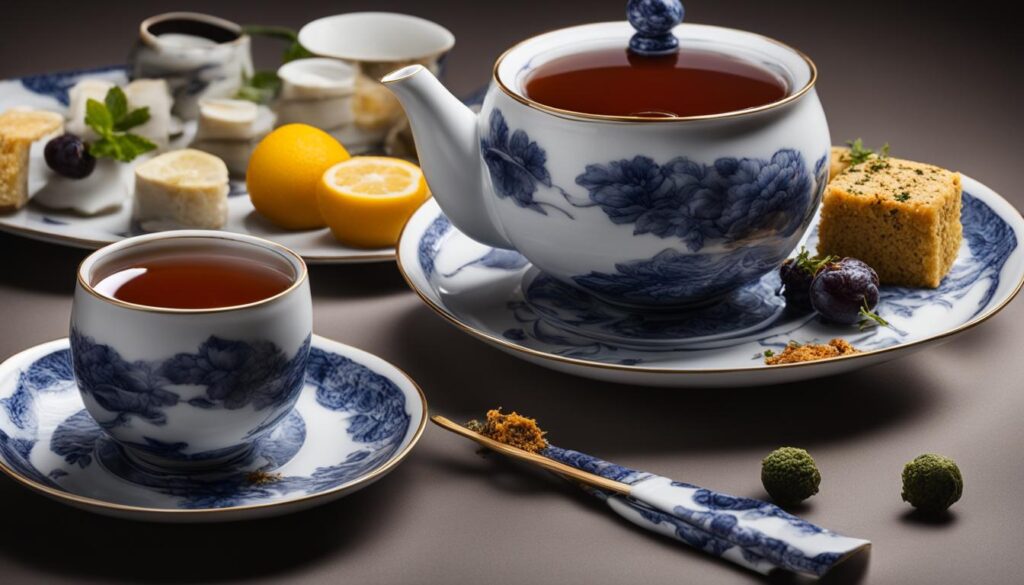
The delightful world of regional cuisine provides endless opportunities to explore and experiment with tea and food pairings. By embracing the science of tea pairing, we can unlock a world of unique flavors and create memorable dining experiences.
Molecular Gastronomy with Tea: Unlocking Flavorful Combinations
When it comes to tea and food pairings, the world of molecular gastronomy offers an exciting realm of possibilities. This innovative culinary discipline explores the science behind food and the fascinating chemical reactions that occur when different ingredients come together. By incorporating tea into the mix, chefs can create unique and flavorful combinations that tantalize the taste buds.
One of the key techniques used in molecular gastronomy is the manipulation of textures. Tea can be used to enhance the experience by introducing new textures or modifying existing ones. For example, infusing tea into a gel or foam can add a delicate and refreshing element to a dish. The inherent flavors of the tea also interact with the other ingredients, creating complex and harmonious taste profiles.
“Tea’s aromatic compounds and natural flavors can be harnessed to create surprising and delightful taste experiences.” – Chef Julia Martinez
The Nutritional Benefits of Tea with Meals
In addition to its culinary possibilities, pairing tea with meals also offers numerous health benefits. Tea is known for its rich antioxidant content, which can help protect the body against oxidative stress and inflammation. The specific antioxidants found in tea, such as catechins and flavonoids, have been linked to a range of health benefits, including improved heart health and reduced risk of chronic diseases.
Moreover, tea can aid in digestion by promoting the production of digestive enzymes and soothing the digestive system. It can also act as a natural palate cleanser, refreshing the taste buds between bites and enhancing the overall dining experience. By incorporating tea into meals, individuals can not only enjoy a delicious and well-rounded culinary adventure but also reap the nutritional rewards.
| Tea Type | Flavor Profile | Best Food Pairings |
|---|---|---|
| Green Tea | Grassy, vegetal | Light seafood, salads |
| Oolong Tea | Floral, fruity | Roasted meats, spicy dishes |
| Black Tea | Malts, rich | Chocolate desserts, hearty stews |
| Herbal Tea | Various flavors | Infused in dishes, baked goods |
As the boundaries of culinary exploration continue to expand, incorporating tea into molecular gastronomy offers a world of exciting possibilities. From creating unique textures to unlocking new flavor combinations, tea has the power to elevate culinary experiences and delight the senses. So why not embark on a journey of flavor and innovation with molecular gastronomy and tea?
The Science Behind Food Pairing
Food pairing is not just a matter of personal preference or guesswork; it is a science that delves into the intricate interactions between different ingredients. By understanding how the flavors of tea and food come together, we can create harmonious and complementary combinations that tantalize the taste buds. One of the fascinating aspects of food pairing is the chemical reactions that occur when tea and food are combined. These reactions can enhance or balance flavors, creating a more complex and satisfying taste experience.
Tea tasting techniques are crucial in understanding how different teas interact with various foods. Just as sommeliers use wine tasting to evaluate and appreciate different wines, tea tasting techniques allow us to fully appreciate the aromas, flavors, and textures of tea in relation to specific foods. By using our senses to analyze the color, aroma, and taste of tea, we can identify its unique characteristics and determine how it complements or contrasts with different flavors in food.
Embracing the science of tea and food pairing opens up a world of possibilities for creating extraordinary and memorable dining experiences. By carefully considering the chemical reactions that occur when combining tea and food, as well as employing tea tasting techniques, we can unlock a myriad of flavor combinations that elevate our culinary adventures. So, let’s dive into the science behind food pairing and explore the endless possibilities that await us at the intersection of tea and cuisine.
Table: Examples of Tea and Food Pairings
| Tea | Food | Pairing Notes |
|---|---|---|
| Green Tea | Sushi | The umami flavors of sushi are complemented by the vegetal notes of green tea, creating a refreshing and harmonious pairing. |
| Oolong Tea | Roast Duck | The rich, smoky flavor of roast duck is accentuated by the toasty and floral notes of oolong tea, resulting in a balanced and complex combination. |
| Black Tea | Chocolate Cake | The bold and robust flavors of black tea stand up to the richness of chocolate cake, creating a decadent and indulgent pairing. |
| Herbal Tea (Peppermint) | Lemon Tart | The cool and refreshing taste of peppermint tea complements the citrusy flavors of lemon tart, providing a zesty and invigorating combination. |
Conclusion
Tea and food pairing is an awe-inspiring science that unravels the secrets behind extraordinary culinary experiences. By delving into the flavor profiles of tea and food, experimenting with different combinations, and exploring regional cuisines, we can unlock a world of unique and delectable flavors.
The art of contrasting pairings adds an element of surprise, while the use of herbs and spices elevates the sensory experience to new heights. With every sip and every bite, we embark on a journey of discovery, embracing the science of tea and food pairings.
So whether you’re a devoted tea enthusiast, a passionate chef, or simply someone who appreciates a flavorful meal, let us dive deep into the realm of tea pairing science. Let us savor the intricacies of taste, the dance of aromas, and the symphony of flavors. Together, we can enhance our culinary adventures and create moments of pure delight.
FAQ
What is tea and food pairing?
Tea and food pairing is the art of combining different types of tea with specific dishes to enhance the flavors of both.
How do you pair tea and food?
When pairing tea and food, consider the flavor profiles of both and aim for a balance of flavors. Experimentation is key to finding the perfect combinations.
What types of tea pair well with light dishes?
Delicate, subtle teas like white and green teas pair well with light dishes.
Can teas with bitterness be paired with food?
Yes, the bitterness of tea can be balanced with sweet or acidic foods to create a harmonious combination.
How does terroir influence tea and food pairings?
Tea from different regions can have unique flavor profiles that can complement specific cuisines, adding an extra layer to the pairing experience.
Are contrasting pairings recommended in tea and food pairing?
Yes, contrasting pairings can create exciting and unique sensory experiences by combining foods and teas that create opposing sensations.
Can herbs and spices be used in tea and food pairing?
Absolutely! Herbs and spices have distinct flavors that can enhance both tea and food, creating well-balanced and delicious pairings.
What is the science behind food pairing?
Food pairing involves understanding how different ingredients interact to create harmonious and complementary flavors, utilizing taste buds, chemical reactions, and the brain’s perception of flavor.

